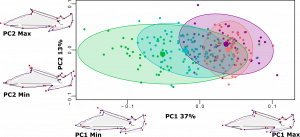Diversity in the internal functional feeding elements of sympatric morphs of Arctic charr (Salvelinus alpinus)
Jónsdóttir, G.Ó., von Elm, L-M, Ingimarsson, F., Tersigni, S., Snorrason, S.S, Pálsson, A. and Steele, S.E.
Submitted to Evolutionary Biology. https://www.biorxiv.org/content/10.1101/2023.02.17.528955v1
Abstract
The diversity of functional anatomy related to feeding is particularly impressive in fishes and correlates with various ecological specializations across species. Polymorphism within species can manifest in divergent feeding morphology and ecology, often along a benthic–pelagic axis. Arctic charr (Salvelinus alpinus) is a freshwater salmonid known for morphological variation and sympatric polymorphism. In Lake Þingvallavatn, Iceland, four morphs of arctic charr coexist that differ in preferred prey, behaviour, habitat use, and external feeding morphology. We studied variation in upper and lower jaw bones (six bones total) related to feeding, in adults of the four morphs using geometric morphometrics and univariate statistics. We tested for allometric differences in bone size and shape among morphs, morph effects on bone size and shape, and if benthic and pelagic ecologies associate with bone size and shape. We also examined the degree of integration between bone pairs. We found differences in bone size between pelagic and benthic morphs for two bones (dentary and premaxilla). There was clear bone shape divergence along a benthic–pelagic axis in four bones (dentary, articular-angular, premaxilla and maxilla), as well as allometric differences between morphs in the dentary. Most dramatic was the dentary, where morph explained more shape variation than bone size. Comparatively, benthic morphs possess a compact and taller dentary, with shorter dentary palate, consistent with visible (but less prominent) differences in external morphology. As these morphs emerged in the last 10,000 years, these results indicate rapid functional evolution of specific feeding structures in arctic charr. This sets the stage for studies of the genetics and development of rapid and parallel craniofacial evolution.

